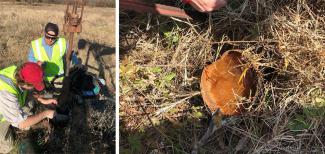NETL’s Natalie Pekney, Ph.D., knows that locating abandoned oil and gas wells — which can leak methane, a potent greenhouse gas — is no walk in the park even with the assistance of state-of-the-art technology.
For starters, there are an estimated 1.2 million abandoned oil and gas wells nationwide, according to the U.S. Environmental Protection Agency (EPA). Many wells were drilled decades before it was necessary to obtain permits, making it difficult to find them using public records and maps. Additionally, many of these wells were never plugged or sealed when production ceased.
Pekney, NTEL Technical Portfolio Lead, and her colleagues recently took a different approach to organize a field campaign to northeastern Oklahoma, a region with a long tradition of oil and gas drilling. For six days in November, a team of NETL scientists, relying largely on information gleaned from various databases, traveled through mostly publicly owned lands, by vehicle and sometimes on foot, to locate abandoned wells and collect methane emission measurements from them.
NETL’s boots-on-the-ground strategy worked. Researches collected methane measurements from approximately 140 abandoned oil and gas wells, easily surpassing their goal to take measurements from 100 abandoned well sites. The team discovered that just 10% percent of the wells were plugged with concrete and other materials. Furthermore, about 10% of the unplugged wells registered measurable leakage rates of methane.
Finding abandoned wells that leak methane is a priority for Pekney and her team. Compared to carbon dioxide (CO2), methane (CH4) accounts for a significantly smaller percentage of all U.S. greenhouse gas emissions. Methane’s lifetime in the atmosphere is much shorter than CO2, but CH4 is more efficient at trapping radiation in the atmosphere than CO2. Pound for pound, the comparative impact of CH4 is greater than CO2 as a greenhouse gas.
“Capturing methane before it leaks into the atmosphere helps reduce the effects of climate change,” Pekney said. “The levels of methane leaking from a single well may be relatively small. However, given the large number of abandoned wells, the cumulative amount of methane they release may be substantial.”
Data from NETL’s work in Oklahoma, along with its other efforts to measure methane emissions from abandoned wells and pipelines in other parts of the country, will be shared with the EPA. The data may then be listed in the EPA’s Greenhouse Gas Inventory, which policymakers use to develop strategies for emissions reductions and to track the progress of those policies.
Field work at abandoned well sites also provides valuable data about how various environmental factors, such as barometric pressure and soil conditions, influence the dispersion of leaking methane into the atmosphere.
Patricia Saint-Vincent, Oak Ridge Institute for Science and Education Postdoctoral Associate for NETL, said being on the ground in Oklahoma yielded unexpected, positive surprises.
“We met and developed relationships with residents who could remember locations of wells that were never documented on public records or maps,” Saint-Vincent said. “They helped us find wells that were covered by thick vegetation or debris and would have been impossible for us to find on our own.”
Well-finding efforts led by NETL are important for several reasons. First, many early wells were not properly sealed when abandoned, leaving pathways for liquids and gases to rise to the surface or flow underground. Poorly sealed wells also can contaminate sources of drinking water and threaten the success of subsurface energy activities, including hydraulic fracking and CO2 storage.
NETL has been researching the issue of abandoned wells for several years. Much of that work has centered around locating abandoned wells in Pennsylvania, and to quantify greenhouse gas emissions from them. NETL partners with state officials to obtain access to public lands and shares findings with the Pennsylvania Department of Environmental Protection, which is responsible for sealing abandoned wells.
NETL plans to complete its next field campaign this spring in Texas.




